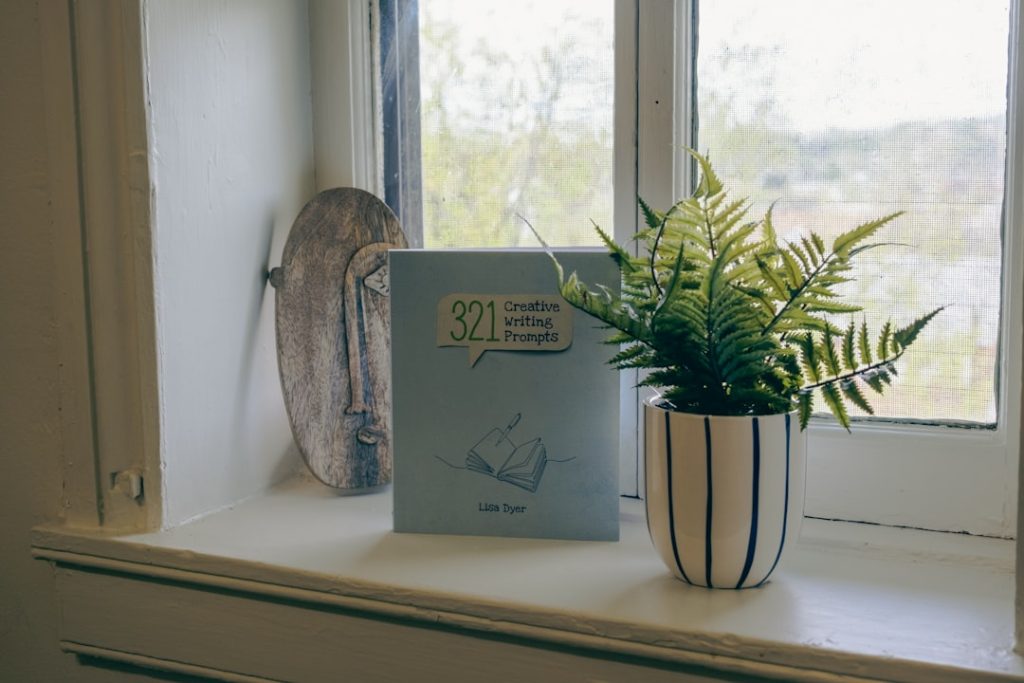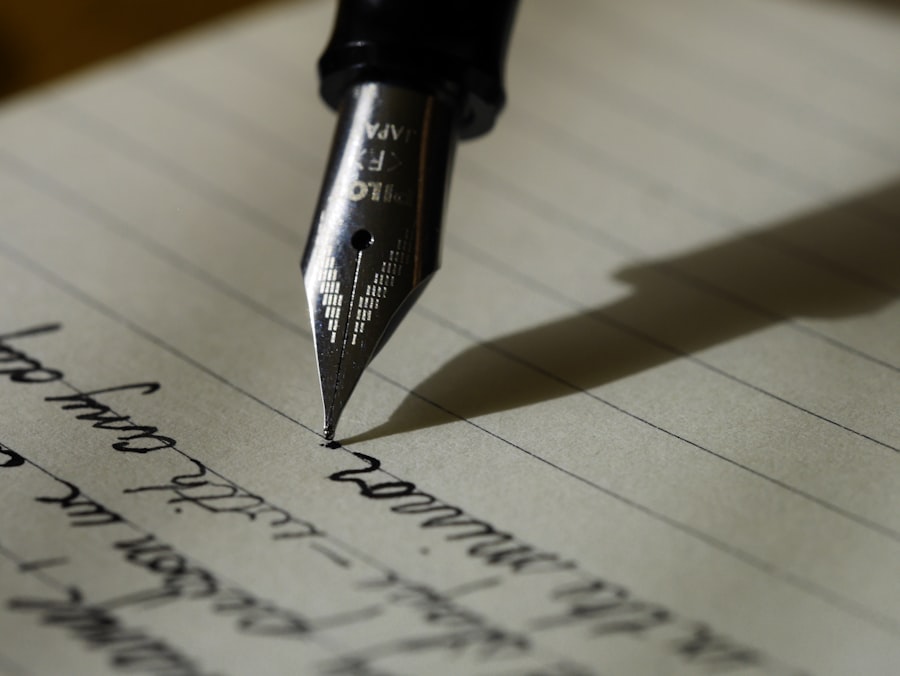
The creative writing process is a multifaceted journey that involves the interplay of imagination, structure, and revision. At its core, creative writing is about expressing thoughts, emotions, and narratives in a way that resonates with readers. This process often begins with inspiration, which can strike at any moment—whether it’s a fleeting thought, a vivid dream, or an observation made during a mundane day.
Writers must learn to recognize these sparks of creativity and cultivate them into fully formed ideas. This initial phase is often chaotic, filled with brainstorming sessions and freewriting exercises that allow the writer to explore various avenues without the constraints of structure or form. As ideas begin to take shape, the writer must navigate the transition from raw inspiration to a more organized framework.
This involves outlining the narrative arc, developing themes, and establishing character motivations. The creative writing process is not linear; it often requires writers to revisit earlier stages, refining their ideas as they gain new insights. For instance, a writer may start with a character’s backstory that evolves significantly as the plot develops.
This iterative process is essential for creating a cohesive and engaging narrative. Understanding that writing is both an art and a craft allows writers to embrace the complexities of their creative journey, recognizing that each draft brings them closer to their vision.
Key Takeaways
- Understanding the creative writing process involves tapping into your imagination and finding inspiration from various sources.
- Developing a strong writing routine is essential for maintaining consistency and productivity in your creative writing endeavors.
- Utilizing various writing prompts and exercises can help overcome writer’s block and stimulate new ideas for your writing projects.
- Exploring different writing styles and genres allows you to expand your creative horizons and find your unique voice as a writer.
- Harnessing the power of imagery and descriptive language can elevate your writing and create a more vivid and immersive experience for your readers.
Developing a Strong Writing Routine
Identifying Your Most Productive Time
The key is to identify when you are most productive and carve out dedicated time for writing. Setting specific goals for each session—whether it’s a word count target or completing a chapter—can provide motivation and a sense of accomplishment.
Creating an Environment Conducive to Writing
In addition to time management, creating an environment conducive to writing is equally important. This might involve finding a quiet space free from distractions or surrounding oneself with inspiring materials, such as books or artwork. Some writers benefit from rituals that signal the start of their writing time, such as brewing a cup of coffee or lighting a candle. These small acts can help transition the mind into a creative state.
Preventing Burnout and Stimulating Creativity
Moreover, incorporating breaks into the routine can prevent burnout and keep ideas flowing. Engaging in activities like walking or meditating can stimulate creativity and provide fresh perspectives on ongoing projects.
Utilizing Various Writing Prompts and Exercises

Writing prompts and exercises serve as valuable tools for sparking creativity and overcoming writer’s block. They can take many forms, from simple phrases or questions to more elaborate scenarios that challenge writers to think outside the box. For example, a prompt might ask writers to describe a day in the life of an inanimate object, encouraging them to adopt unique perspectives and explore unconventional narratives.
These exercises not only stimulate creativity but also help writers experiment with different styles and voices without the pressure of producing polished work. Incorporating prompts into regular writing practice can also enhance skills such as character development and dialogue creation. For instance, a prompt that requires writing a conversation between two characters with opposing viewpoints can deepen understanding of conflict and resolution in storytelling.
Additionally, timed writing exercises can push writers to think quickly and trust their instincts, fostering spontaneity in their work. By regularly engaging with prompts and exercises, writers can expand their creative horizons, discover new interests, and ultimately enrich their primary writing projects.
Exploring Different Writing Styles and Genres
| Writing Style/Genre | Characteristics | Examples |
|---|---|---|
| Descriptive Writing | Uses sensory details to create a vivid picture | Ex: “The sun was setting, casting a warm orange glow over the mountains” |
| Narrative Writing | Tells a story with a clear beginning, middle, and end | Ex: Novels, short stories |
| Persuasive Writing | Convinces the reader to agree with the author’s opinion | Ex: Advertisements, opinion pieces |
| Poetry | Uses rhythm, rhyme, and imagery to evoke emotions | Ex: Sonnets, haikus |
Diving into various writing styles and genres is essential for any writer seeking to broaden their skills and find their unique voice. Each genre—be it fiction, poetry, or non-fiction—has its own conventions and techniques that can inform a writer’s approach. For instance, writing poetry often emphasizes rhythm, imagery, and brevity, while fiction may focus more on narrative structure and character development.
Moreover, exploring diverse styles can enhance a writer’s versatility. A novelist might find inspiration in the concise language of flash fiction or the emotional depth of personal essays.
Engaging with various genres also allows writers to analyze how different authors tackle similar themes or subjects, providing insights into effective storytelling techniques. For example, reading magical realism can inspire a writer to incorporate fantastical elements into their otherwise realistic narratives. This exploration not only enriches a writer’s toolkit but also fosters an appreciation for the vast landscape of literature.
Harnessing the Power of Imagery and Descriptive Language
Imagery and descriptive language are powerful tools in a writer’s arsenal, capable of transforming ordinary prose into vivid experiences for readers.
For instance, instead of simply stating that a character walked through a forest, a writer might describe the dappled sunlight filtering through leaves, the earthy scent of damp soil, and the rustle of unseen creatures in the underbrush.
Such details create an atmosphere that draws readers in and evokes emotional responses. Descriptive language also plays a crucial role in character development and setting establishment. By carefully choosing words that convey specific emotions or moods, writers can shape how readers perceive characters and their environments.
For example, describing a character’s home as “a cluttered sanctuary filled with mismatched furniture” paints a picture of warmth and individuality, while “a sterile apartment devoid of personality” suggests isolation or detachment. The strategic use of imagery not only enhances storytelling but also allows writers to convey complex themes subtly through their descriptions.
Crafting Compelling Characters and Storylines

Creating compelling characters is at the heart of effective storytelling; they are often what readers connect with most deeply. A well-rounded character possesses distinct traits, motivations, and flaws that make them relatable and memorable. Writers should invest time in developing backstories that inform their characters’ actions and decisions throughout the narrative.
For instance, understanding why a character fears commitment can add layers to their relationships and drive conflict within the story. Additionally, characters should evolve over time; witnessing their growth or decline keeps readers engaged and invested in their journeys. Equally important is crafting storylines that captivate readers from beginning to end.
A strong plot typically includes elements such as conflict, tension, and resolution that propel the narrative forward. Writers should consider employing techniques like foreshadowing or cliffhangers to maintain suspense and encourage readers to turn pages eagerly. Moreover, intertwining subplots can enrich the main storyline by adding depth and complexity to characters’ lives.
For example, a protagonist’s struggle with personal demons might parallel an external conflict they face in their community, creating a multifaceted narrative that resonates on multiple levels.
Revising and Editing for Clarity and Impact
The revision process is where much of the magic happens in creative writing; it transforms initial drafts into polished works ready for readers’ eyes. This stage involves critically assessing content for clarity, coherence, and impact. Writers should approach revision with fresh eyes—often after taking a break from the manuscript—to identify areas needing improvement more effectively.
This might include restructuring sentences for better flow or eliminating unnecessary words that dilute meaning. The goal is to ensure that every word serves a purpose in advancing the narrative or enhancing character development. Editing also encompasses checking for grammatical errors and inconsistencies that could distract readers from the story itself.
While some writers prefer to tackle these issues during revision, others find it helpful to separate editing from content changes entirely. Utilizing tools like grammar checkers or seeking assistance from beta readers can provide additional perspectives on areas needing refinement. Ultimately, revising and editing are integral parts of the writing process that elevate a piece from rough draft to compelling narrative.
Seeking Feedback and Continuous Improvement
Feedback is an invaluable component of growth for any writer; it offers insights into how others perceive your work and highlights areas for improvement that may not be immediately apparent to you as the creator. Engaging with fellow writers through workshops or critique groups can foster an environment where constructive criticism thrives. When receiving feedback, it’s essential to approach it with an open mind—recognizing that differing opinions can provide new perspectives on your writing style or narrative choices.
Continuous improvement is vital in honing one’s craft; writers should actively seek opportunities for learning through reading widely across genres, attending writing conferences, or enrolling in workshops focused on specific skills like dialogue or pacing. Embracing this mindset not only enhances technical abilities but also nurtures creativity by exposing writers to diverse influences and techniques. By remaining committed to growth through feedback and education, writers can evolve their craft over time, ultimately leading to more impactful storytelling experiences for their readers.
If you’re looking to improve your creative writing techniques, you may want to check out the article on sersea.ink that discusses the importance of reading books in order to enhance your writing skills. Reading a variety of genres and styles can help inspire new ideas and approaches to storytelling. By immersing yourself in the works of other authors, you can learn different techniques and gain a deeper understanding of the craft of writing.
FAQs
What are creative writing techniques?
Creative writing techniques are strategies and methods used by writers to enhance their writing and create more engaging and impactful content. These techniques can include various literary devices, storytelling approaches, and language usage to bring creativity and originality to the writing.
What are some examples of creative writing techniques?
Examples of creative writing techniques include imagery, metaphor, simile, symbolism, foreshadowing, flashback, dialogue, character development, plot structure, point of view, and narrative voice. These techniques are used to add depth, emotion, and vividness to the writing.
How can creative writing techniques improve writing?
Creative writing techniques can improve writing by making it more engaging, expressive, and memorable. By using these techniques, writers can evoke emotions, create vivid imagery, and captivate readers, ultimately enhancing the overall impact of their writing.
Are there any specific guidelines for using creative writing techniques?
While there are no strict rules for using creative writing techniques, it is important for writers to use them thoughtfully and purposefully. It’s essential to consider the context, audience, and intended effect when incorporating these techniques into writing.
Can anyone learn and use creative writing techniques?
Yes, anyone can learn and use creative writing techniques with practice and dedication. Whether you are a beginner or an experienced writer, studying and experimenting with various techniques can help enhance your writing skills and creativity.



